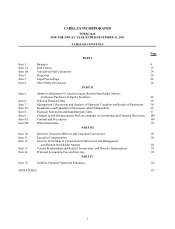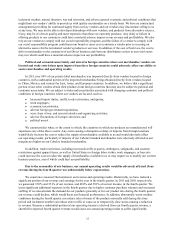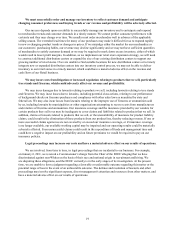Cabela's 2011 Annual Report Download - page 23
Download and view the complete annual report
Please find page 23 of the 2011 Cabela's annual report below. You can navigate through the pages in the report by either clicking on the pages listed below, or by using the keyword search tool below to find specific information within the annual report.13
Difficult conditions in the economy generally may materially adversely affect our business and results
of operations.
Our results of operations are materially affected by conditions in the economy generally. Factors such as
consumer spending, oil prices, unemployment rates, the availability of credit, and the volatility and strength
of the capital markets all affect the business and macroeconomic environment and, ultimately, the revenue and
profitability of our business. In an economic environment characterized by higher unemployment, lower family
income, and lower consumer spending, the demand for our products could be adversely affected. This may
materially affect our business and results of operations.
Competition in the outdoor recreation and casual apparel and footwear markets could reduce our
revenue and profitability.
The outdoor recreation and casual apparel and footwear markets are highly fragmented and competitive. We
compete directly or indirectly with the following types of companies:
• other specialty retailers that compete with us across a significant portion of our merchandising categories
through retail store or direct businesses, such as Bass Pro Shops, Gander Mountain, Orvis, The
Sportsman’s Guide, and Sportsman’s Warehouse;
• large-format sporting goods stores and chains, such as The Sports Authority, Dick’s Sporting Goods, and
Big 5 Sporting Goods;
• retailers that currently compete with us through retail businesses that may enter the direct business;
• mass merchandisers, warehouse clubs, discount stores, and department stores, such as Wal-Mart, Target,
and Amazon; and
• casual outdoor apparel and footwear retailers, such as L.L. Bean, Lands’ End, and REI.
Many of our competitors have a larger number of stores, and some of them have substantially greater market
presence, name recognition, and financial, distribution, marketing, and other resources than we have. In addition,
if our competitors reduce their prices, we may have to reduce our prices in order to compete. Furthermore, some
of our competitors have aggressively built new stores in locations with high concentrations of our Direct business
customers. As a result of this competition, we may need to spend more on advertising and promotion. Some of
our mass merchandising competitors, such as Wal-Mart, do not currently compete in many of the product lines
we offer. If these competitors were to begin offering a broader array of competing products, or if any of the
other factors listed above occurred, our revenue could be reduced or our costs could be increased, resulting in
reduced profitability.
We may not be able to raise additional capital or obtain additional financing if needed.
We regularly review and evaluate our liquidity and capital needs. We currently believe that our available cash,
cash equivalents, and cash flow from operations will be sufficient to finance our operations and expected capital
requirements for at least the next 12 months. However, we might experience periods during which we encounter
additional cash needs and we might need additional external funding to support our operations. Although we were
able to enter into a $415 million revolving credit facility during fiscal 2011 on acceptable terms, in the event we
require additional liquidity, we cannot be certain that additional funds will be available if needed and to the extent
required or, if available, on acceptable terms. If we cannot raise necessary additional funds on acceptable terms,
there could be a material adverse impact on our business and results of operations. We also may not be able to fund
expansion, take advantage of future opportunities, meet our existing debt obligations, or respond to competitive
pressures or unanticipated requirements.
























